Taiwan Optoelectronics Market Size
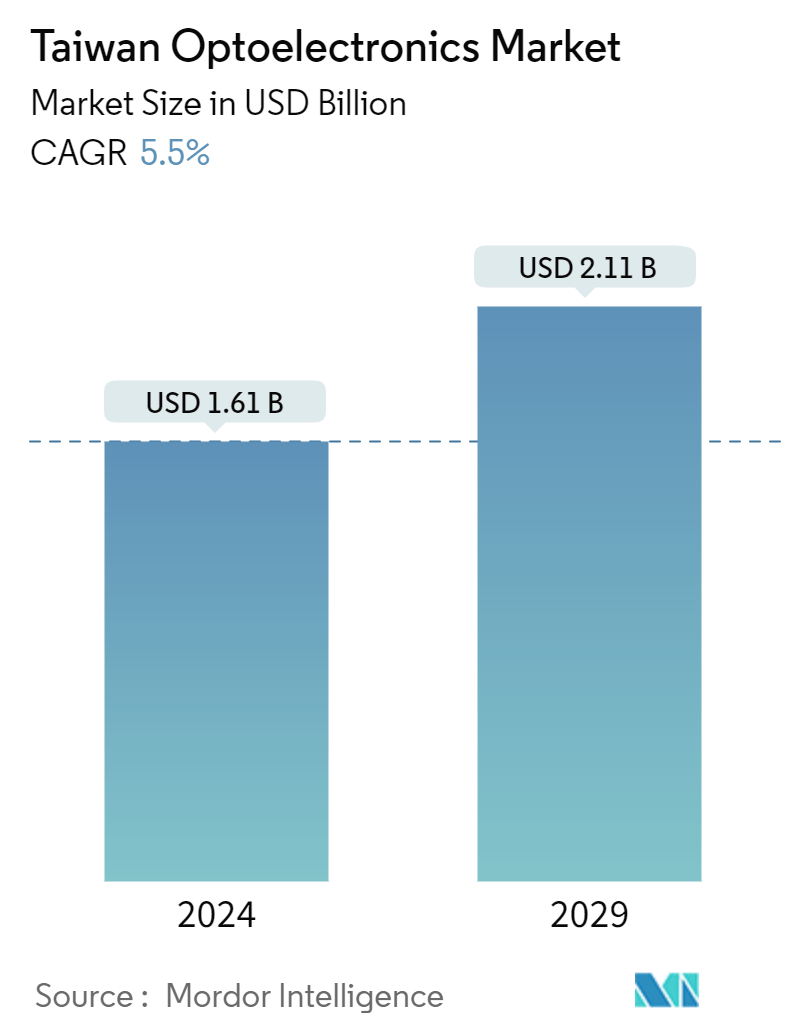
| Study Period | 2019 - 2029 |
| Base Year For Estimation | 2023 |
| Market Size (2024) | USD 1.61 Billion |
| Market Size (2029) | USD 2.11 Billion |
| CAGR (2024 - 2029) | 5.50 % |
| Market Concentration | Low |
Major Players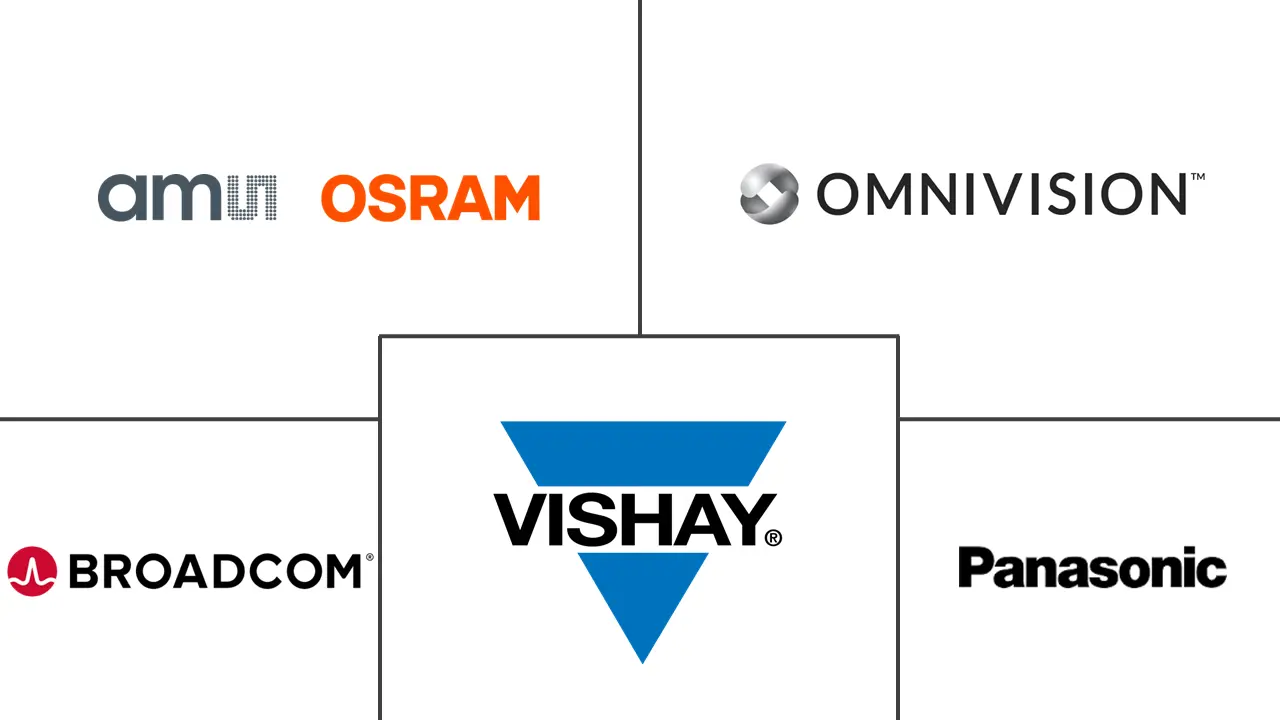
*Disclaimer: Major Players sorted in no particular order |
Taiwan Optoelectronics Market Analysis
The Taiwan Optoelectronics Market size is estimated at USD 1.61 billion in 2024, and is expected to reach USD 2.11 billion by 2029, growing at a CAGR of 5.5% during the forecast period (2024-2029).
- The current trends in the optoelectronics market focus on minimizing the dimensions of devices and enhancing integration within systems, such as arrays of LEDs, laser arrays, and systems that incorporate other electronic components on a single chip. The merging of optical communication, optical storage, and optical imaging sectors is pushing advancements in optoelectronics. The Increasing need for intelligent consumer electronics and cutting-edge technologies in Taiwan is expected to drive the use of optoelectronics.
- LED technology development has seen significant advancements over the years in Taiwan. Initially, LEDs were available only in a few basic types and colors. Still, new types of chemical structures, such as InGaAIP and GaAIAs, have been created to obtain new colors and wavelengths and improve performance and reliability. In January 2024, Taiwanese company AUO, specializing in optoelectronic solutions, began producing Micro LEDs at the close of 2023. These Micro LEDs target high-end smartwatch manufacturers, focusing on achieving cost efficiency.
- 5G technology, enabled by optoelectronics, supports extended reality (XR) applications, which encompass virtual reality (VR), augmented reality (AR), and mixed reality (MR) experiences. Taiwan is spearheading initiatives to accelerate the rollout of 5G and 6G communication technologies. The rising uptake of 5G networks is poised to propel the market's growth in the nation significantly. According to GSMA, in 2023, 5G mobile connections in Taiwan accounted for 37%, projected to surge to 56% by 2025 and 96% by 2030.
- Manufacturing and fabricating optoelectronics entail high initial costs, posing notable restraints in the market. Despite rising demand across industries, these costs impede market growth. The industrial sector, particularly in laser and machine vision systems, is witnessing a surge in demand for optoelectronic components fueled by the adoption of advanced manufacturing technologies. The sector's high manufacturing costs are partly attributed to notable technological advancements in optoelectronics.
- Inflation, a key macroeconomic factor, notably influences the manufacturing landscape, often translating to escalated production expenses. This uptick in costs may be attributed to several reasons, including surging raw material prices, heightened shipping expenses, and labor shortages. Consequently, manufacturers might be compelled to hike prices to safeguard their profit margins, which typically dampens consumer demand. Inflation may trigger contract constrictions, labor realignments, and procurement challenges for manufacturers. Given these dynamics, the mounting inflationary pressures could impede the studied market's growth trajectory.
Taiwan Optoelectronics Market Trends
Automotive Industry is Expected to Witness a Significant Growth
- Optoelectronics are progressively utilized in cars to automate vehicle operations such as headlights, brakes, and other safety systems. Optical-electronic devices are slowly integrated into vehicle safety features such as night vision systems. These systems utilize active or passive infrared technology to enhance a driver's visibility beyond the range of headlights, particularly in unfavorable driving conditions. Laser diode technology is used to implement LiDAR systems for autonomous driving.
- The surging demand in the automotive industry, specifically with the adoption of electric vehicles in Taiwan, is expected to boost the adoption of optoelectronic devices, further driving the market studied. Starting July 1, 2024, the Taiwanese government would introduce dedicated insurance plans for electric vehicles (EVs), mirroring the rates for traditional gas-powered vehicles. The government has rolled out new insurance schemes designed for Electric Vehicles (EVs), ensuring that owners of traditional gas-powered vehicles are no longer burdened with subsidizing the repair expenses of EVs.
- Automakers are phasing out old incandescent light bulbs and replacing them with LED lights for interior and exterior applications, offering advantages like flexibility in installation and unique lighting designs. LED technology, including Micro LED displays, is being deployed for automotive applications, such as head-ups and transparent displays, offering new opportunities for LED makers in the automotive industry.
- In July 2024, Ennostar, a Taiwan-based company, is pioneering Micro LED technology for automotive use. It's actively collaborating with partners and intensifying its R&D efforts to gear up for mass production. The company is set to notably enhance the uniformity of COW this year to accelerate its production timeline, surpassing 2023's standards. Ennostar predicts that as the demand for autonomous vehicles and smart cockpits rises, Micro LED technology is set to emerge as a leading display choice for upcoming vehicles.
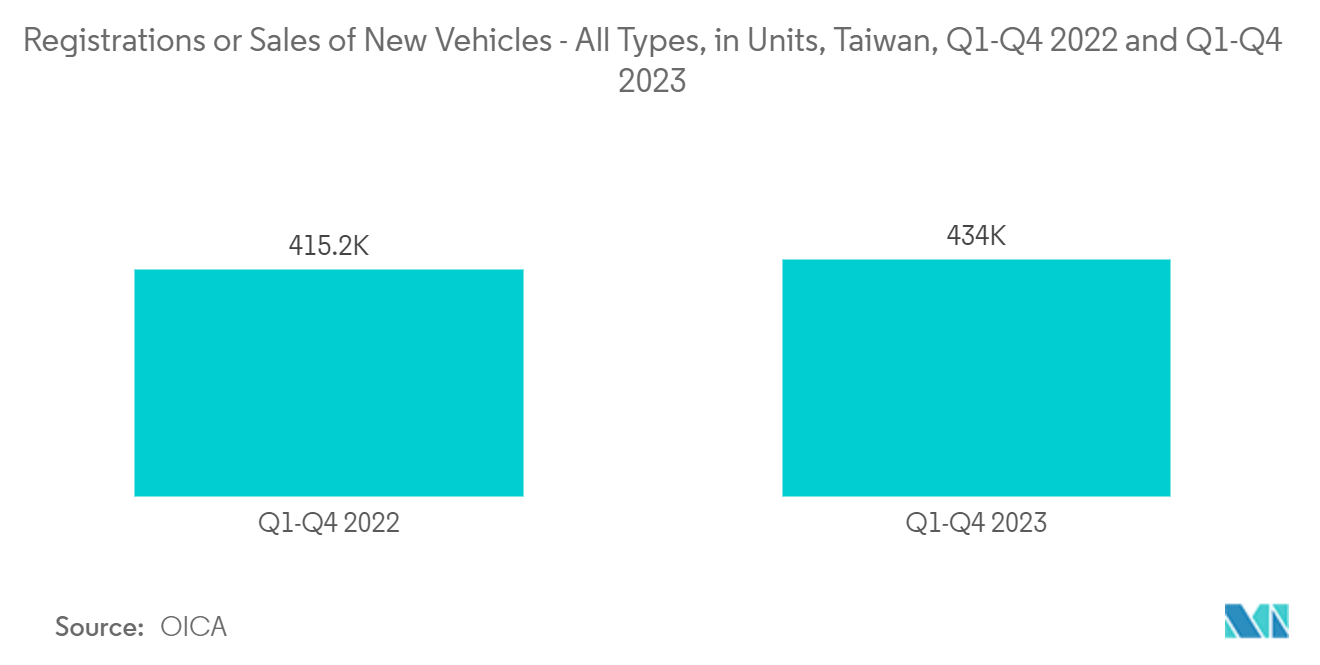
Image Sensors are Expected to Hold a Significant Market Share
- Image sensors play a vital role in optoelectronics by enabling cameras and imaging devices to transform photons into electrical signals, which can then be analyzed and manipulated. The first digital cameras used charge-coupled devices (CCDs) to facilitate the movement of electrical charge through the device for modulation. However, modern cameras predominantly use complementary metal-oxide-semiconductor (CMOS) sensors due to their low power consumption, high integration, and compatibility with standard CMOS fabrication processes.
- With the surging demand for high-definition image-capturing devices in various industries, CMOS technology has experienced a high adoption rate. CMOS technology provides a faster shutter speed while delivering high-quality images. In September 2023, Sony Semiconductor Solutions Corporation (SSS) announced the IMX735, an advanced CMOS image sensor designed for automotive cameras. With an impressive 17.42 effective megapixels, this sensor establishes a new standard in the industry.
- Incorporating cameras in smartphones has led to a noticeable increase in image capturing, coinciding with the rise in smartphone penetration. According to BOFT (Taiwan), Taiwan's mobile phone imports surged to approximately USD 1.19 billion by 2023. Over the past decade, Taiwan transitioned from being a mobile phone exporter to a significant importer. These factors are set to drive the market for image sensors. Due to the increasing need for high-quality image-capturing equipment in various industries, there has been a notable rise in the use of CMOS technology.
- While companies like Sony, Samsung, SK Hynix, Vishay Intertechnology Inc., and ST have long histories of R&D investments, relatively new companies are also keeping pace regarding the levels of technology innovations. In June 2024, Samsung Electronics introduced three advanced mobile image sensors designed for primary and secondary cameras in smartphones. These sensors include the ISOCELL HP9, the ISOCELL GNJ, and the ISOCELL JN5. The ISOCELL HP9 boasts 200 million pixels, each measuring 0.56 μm, within a 1/1.4-inch optical format.
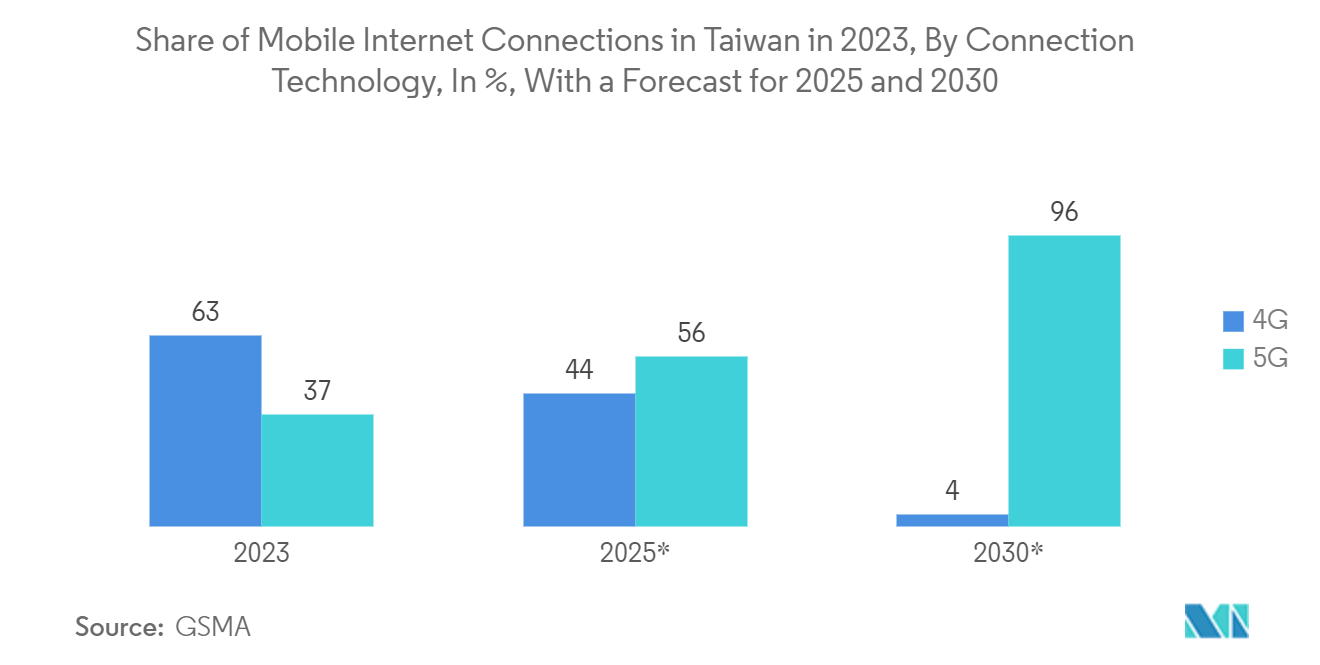
Taiwan Optoelectronics Industry Overview
The Taiwanese optoelectronics market is fragmented, with the presence of major players like Ams Osram AG, Omnivision Technologies Inc., Broadcom Inc., Vishay Intertechnology Inc., Panasonic Corporation, and Samsung Electronics Co. Ltd. Players in the market are adopting strategies such as partnerships, mergers, innovations, investments, and acquisitions to enhance the product offerings and gain sustainable competitive advantage.
- In July 2024, Infinix partnered with Samsung, leveraging Samsung's ISOCELL image sensor software algorithm, featuring a 108 MP AI-powered deep learning lens. This advanced lens, AIADLA, enhanced image processing, allowing users to capture high-resolution images with remarkable detail, even from a distance, using their primary mobile camera. Infinix claimed that the AIADLA significantly improved the user experience by minimizing noise and distortion, especially in low-light settings.
- In December 2023, Samsung Electronics collaborated with SK Hynix to make strides in commercializing On-sensor AI technology for image sensors. The companies aimed to elevate the image sensor technologies centered around AI and challenge the Sony company to dominate the next-generation market. The company is carrying out proof-of-concept studies emphasizing facial and object recognition capabilities. These studies involved a Computing In Memory (CIM) accelerator, a new technology capable of conducting the necessary multiplication and addition operations for AI model calculations.
Taiwan Optoelectronics Market Leaders
-
ams Osram AG
-
Omnivision Technologies Inc
-
Broadcom Inc.
-
Vishay Intertechnology, Inc
-
Panasonic Corporation
*Disclaimer: Major Players sorted in no particular order
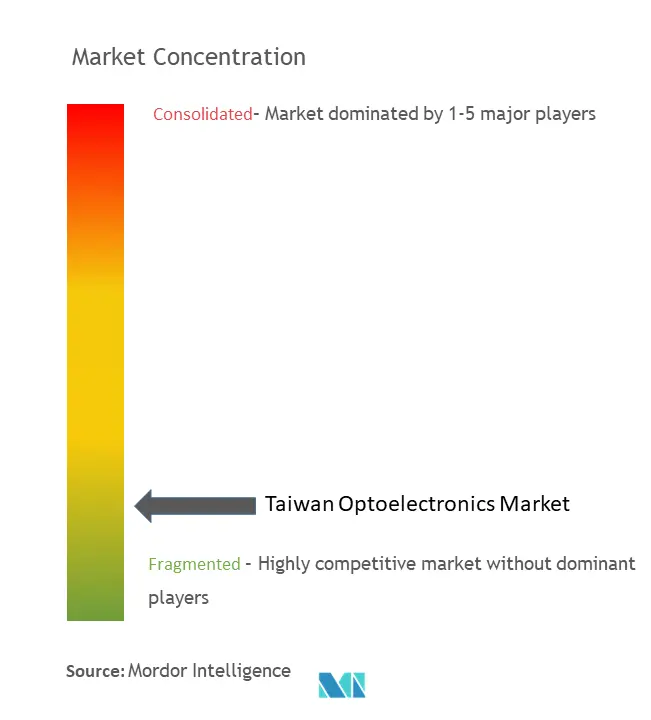
Taiwan Optoelectronics Market News
- May 2024: Vishay Intertechnology Inc. introduced a high-speed optocoupler boasting a 25 MBd transmission rate. This optocoupler is designed for digital systems and sports a CMOS logic digital input and output interface. Designed with industrial applications in mind, the single-channel VOIH72A stands out with its impressive specs: a mere 6 ns maximum pulse width distortion, a modest 2 mA maximum supply current, and a broad supply voltage range spanning from 2.7 V to 5.5 V. It is engineered for high-temperature environments, capable of operating up to +110 °C.
- January 2024: Ams Osram introduced a new range of low-power LEDs called the SYNIOS P1515 side lookers, which make design easier, simplify implementation, and enable a uniform look in extended light bars and other automotive rear lighting applications. By using these side-looker LEDs instead of top-looker LEDs, car manufacturers may achieve a seamless appearance throughout the vehicle's width. With the same number of LEDs as a setup using top looker LEDs, a rear combination lamp (RCL) or turn indicator can be made with a slimmer and simpler optical assembly.
Taiwan Optoelectronics Market Report - Table of Contents
1. INTRODUCTION
1.1 Study Assumptions and Market Definition
1.2 Scope of the Study
2. RESEARCH METHODOLOGY
3. EXECUTIVE SUMMARY
4. MARKET INSIGHTS
4.1 Market Overview
4.2 Industry Attractiveness - Porter's Five Forces Analysis
4.2.1 Bargaining Power of Suppliers
4.2.2 Bargaining Power of Consumers
4.2.3 Threat of New Entrants
4.2.4 Threat of Substitute Products
4.2.5 Intensity of Competitive Rivalry
4.3 Industry Value Chain Analysis
4.4 Impact of COVID-19 Aftereffects and Other Macroeconomic Factors on the Market
5. MARKET DYNAMICS
5.1 Market Drivers
5.1.1 Growing demand for Smart Consumer Electronics and Next Generation Technologies
5.1.2 Increasing Industrial Applications of the Technology
5.2 Market Challenges
5.2.1 High Manufacturing and Fabrication Costs
5.2.2 Challenges with Energy Loss and Heating of Optoelectronic Devices
6. MARKET SEGMENTATION
6.1 By Device Type
6.1.1 LED
6.1.2 Laser Diode
6.1.3 Image Sensors
6.1.4 Optocouplers
6.1.5 Photovoltaic Cells
6.1.6 Other Device Types
6.2 By End-user Industry
6.2.1 Automotive
6.2.2 Aerospace and Defense
6.2.3 Consumer Electronics
6.2.4 Information Technology
6.2.5 Healthcare
6.2.6 Residential and Commercial
6.2.7 Industrial
6.2.8 Other End-user Industries
7. COMPETITIVE LANDSCAPE
7.1 Company Profiles*
7.1.1 ams Osram AG
7.1.2 Omnivision Technologies Inc.
7.1.3 Broadcom Inc.
7.1.4 Vishay Intertechnology Inc
7.1.5 Panasonic Corporation
7.1.6 Samsung Electronics Co. Ltd
7.1.7 Sony Corporation
7.1.8 Texas Instruments Inc.
7.1.9 LITE-ON Technology Corporation
7.1.10 Rohm Co. Ltd
7.1.11 Mitsubishi Electric Corporation
7.1.12 SK Hynix Inc.
7.1.13 Sharp Corporation
8. INVESTMENT ANALYSIS
9. FUTURE OF THE MARKET
Taiwan Optoelectronics Industry Segmentation
Optoelectronics, which falls under the umbrella of photonics, involves studying and applying electronic systems that manipulate light. In this context, light encompasses visible light and other forms of radiation like gamma rays, X-rays, ultraviolet, and infrared. Optoelectronic devices serve as transducers, converting electrical signals to optical ones or vice versa, and are integral to various instruments' functionality.
The study tracks the revenue accrued through the sale of optoelectronic devices by various players in Taiwan. The study also tracks the key market parameters, underlying growth influencers, and major vendors operating in the industry, which supports the market estimations and growth rates over the forecast period. The study further analyzes the overall impact of COVID-19 aftereffects and other macroeconomic factors on the market. The report's scope encompasses market sizing and forecasts for the various market segments.
The Taiwanese optoelectronics market is segmented by device type (LED, laser diode, image sensors, optocouplers, photovoltaic cells, and other device types) and end-user industry (automotive, aerospace and defense, consumer electronics, information technology, healthcare, residential and commercial, industrial, and other end-user industries). The report offers the market size in value terms in USD for all the abovementioned segments.
| By Device Type | |
| LED | |
| Laser Diode | |
| Image Sensors | |
| Optocouplers | |
| Photovoltaic Cells | |
| Other Device Types |
| By End-user Industry | |
| Automotive | |
| Aerospace and Defense | |
| Consumer Electronics | |
| Information Technology | |
| Healthcare | |
| Residential and Commercial | |
| Industrial | |
| Other End-user Industries |
Taiwan Optoelectronics Market Research FAQs
How big is the Taiwan Optoelectronics Market?
The Taiwan Optoelectronics Market size is expected to reach USD 1.61 billion in 2024 and grow at a CAGR of 5.5% to reach USD 2.11 billion by 2029.
What is the current Taiwan Optoelectronics Market size?
In 2024, the Taiwan Optoelectronics Market size is expected to reach USD 1.61 billion.
Who are the key players in Taiwan Optoelectronics Market?
ams Osram AG, Omnivision Technologies Inc, Broadcom Inc., Vishay Intertechnology, Inc and Panasonic Corporation are the major companies operating in the Taiwan Optoelectronics Market.
What years does this Taiwan Optoelectronics Market cover, and what was the market size in 2023?
In 2023, the Taiwan Optoelectronics Market size was estimated at USD 1.52 billion. The report covers the Taiwan Optoelectronics Market historical market size for years: 2019, 2020, 2021, 2022 and 2023. The report also forecasts the Taiwan Optoelectronics Market size for years: 2024, 2025, 2026, 2027, 2028 and 2029.
Taiwan Optoelectronics Industry Report
Statistics for the 2024 Taiwan Optoelectronics market share, size and revenue growth rate, created by Mordor Intelligence™ Industry Reports. Taiwan Optoelectronics analysis includes a market forecast outlook for 2024 to 2029 and historical overview. Get a sample of this industry analysis as a free report PDF download.



